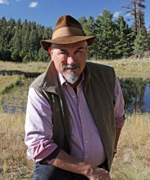 —Alan Dulaney
—Alan Dulaney
How do you sum up a year like 2020? Endless electioneering? COVID-19 pandemic panic with zero preparation? Masks and distancing and no congregating indoors? Zoom meetings from home? Wild swings on Wall Street? Jobs, contracts, and economic futures assessed week by week?
In the world of Western water, several trends flowed inexorably onward through the year. The major drought that began in 1999 (aka megadrought, climactic shift, hotter and drier) continued silently, adversely impacting range conditions, forest health, and runoff. Major fires in Colorado and California damaged watersheds, and will lead to surface water quality degradation that Arizona has seen in the past with its own huge fires. Drought is an endless succession of sunny days, which would have been a great tourist draw, except that there were no tourists in 2020.
The Reconsultation process is also slowing moving forward. Before the end of 2025, the Secretary of the Interior must update the 2007 shortage-sharing guidelines for the Upper and Lower Basins of the seven Colorado River Basin states. As hotter and drier conditions tighten their grip, the reality of a declining supply serves to focus the attention for all Basin states on the development of the new guidelines. In October, the Bureau of Reclamation asked for comments on its review of past operations of Lakes Mead and Powell, which is the essence of Colorado River management. They attempted to explore what has worked in the past, and thus might prove useful in the future. Arizona noted in its comments that Intentionally Created Surplus in the Lower Basin as maintained water level elevations in Lake Mead such that no shortage declarations have proven necessary. Arizona also pointed out that ICS was a major concept underlying the Drought Contingency Plan, and should be recognized as an important tool. You can read about the Arizona Reconsultation Committee here. Not all entities making comments have voiced firm positions in public, but tough negotiations clearly lie ahead.
All meetings are now virtual, most via Zoom or Webex. For AHS, this has meant a doubling (sometimes more) of attendance at chapter meetings. This trend will probably not abate after the pandemic ebbs, as online talks are easy to attend. AHS chapters may have to find new and safe ways to meet in person, such that networking (so important to many, especially students in search of jobs) can once again prove a membership advantage. One advantage of Zoom, however, is that meetings can be recorded, and replayed later to hear the talk again. And there have been some great talks!
Vaccines are on the way, and the pandemic may subside in the summer of 2021. Economic recovery could take considerably longer. Some segments of the economy may never return to 2019 levels. The drought is unlikely to abate, and neglected environmental issues are likely to re-emerge. A shift in priorities associated with water will probably be a major focus of the incoming Biden administration. What that could mean for the water world is yet unknown, but potentially could result in more activity than has been seen in recent years. One thing is certain: hydrologists and water professionals will continue to be in demand.